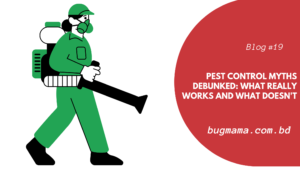
Myth 1: Ultrasonic Repellents Keep Pests Away
One of the most common pest control myths is that ultrasonic repellents effectively keep pests out of our homes. These devices emit high-frequency sound waves that are supposed to repel pests like rodents and insects.
However, studies have shown mixed results regarding their effectiveness. While some claim success with ultrasonic repellents, many others report no significant impact on pest populations.
Professional pest control services, on the other hand, are based on extensive knowledge of pest behavior and biology. They use targeted methods to address specific pest issues, making them a more reliable option for long-term pest management.
Myth 2: Cats Are the Ultimate Rodent Repellents
It’s a popular belief that having a cat in the house will prevent rodent infestations. While it’s true that cats are natural hunters and may catch a few mice, they are not a foolproof solution. Some cats may not have the hunting instinct, and others may only catch a small number of rodents, which won’t be sufficient to control an infestation.
For effective rodent control, homeowners should focus on sealing entry points, eliminating food sources, and setting up traps in strategic locations. This integrated approach is more likely to yield positive results.
Myth 3: Natural Remedies Are Always Safe and Effective
Many people turn to natural remedies for pest control, assuming they are safe and eco-friendly. While some natural solutions can be effective, not all of them are foolproof or entirely safe. For example, using essential oils like peppermint oil to repel pests may have limited efficacy and could be harmful to pets or small children if ingested.
To strike a balance between natural and effective pest control, it’s essential to research the specific remedy and understand its potential risks. In some cases, it may be more practical to opt for eco-friendly commercial pest control products that are tested and proven.
Myth 4: Cheese Is the Best Bait for Mouse Traps
The image of a mouse trap with cheese as bait is deeply ingrained in popular culture. However, in reality, mice are not particularly drawn to cheese. They are more likely to be attracted to high-calorie foods like peanut butter or chocolate.
When setting mouse traps, it’s crucial to use baits that mice find irresistible. This increases the chances of successfully capturing the rodents and preventing further infestations.
FAQs
Are ultrasonic repellents completely useless?
Ultrasonic repellents may have limited effectiveness, but they are not entirely useless. However, professional pest control services offer more reliable results.
Can cats help with pest control at all?
Yes, cats can be helpful in catching some pests, but they are not a guaranteed solution for infestations.
Are all-natural pest control remedies safe?
Not all natural remedies are safe, and some may have limited efficacy. It’s essential to research and use them with caution.
What is the best bait for mouse traps?
Peanut butter and chocolate are more effective baits for mouse traps than cheese.
Conclusion
Debunking pest control myths is essential for effective pest management. Relying on false information can lead to wasted time, money, and increased pest problems.
By understanding the truth behind common misconceptions and adopting evidence-based pest control strategies, homeowners can ensure a pest-free living environment.
